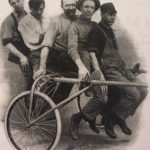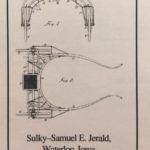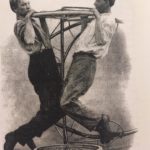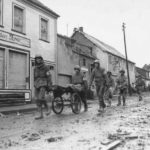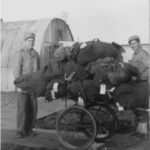“Yet a part of you still believes you can fight and survive no matter what your mind knows. It’s not so strange. Where there’s still life, there’s still hope. What happens is up to God.” ―Devil at My Heels by Louis Zamperini, World War II POW
“During the early days at the height of the racing business, there were over a dozen sulky manufacturers.” –Harness Racing Vehicles, by Susan Green
In 1906, over six hundred horse racing tracks existed across the United States. Twenty-three years later, in 1929, the US Stock Market crashed, escorting in The Great Depression. “The Crash” devastated investments, businesses, and industries worldwide.
Adapting in Adversity
The Jerald Sulky Company of Waterloo, Iowa survived “The Crash” (along with its satellite company branch in Sterling, Pennsylvania).
Amidst the economic chaos, the company literally rose from the ashes after a fire destroyed their factory in the late ’30s.
In 1939, as the new factory (known for producing a sulky design with “superior aerodynamic design”) was rebuilding, WWII exploded when Germany invaded Poland.
Sulky Manufacturing Switches to the War Effort
Triggered by the Japanese bombardment of the American fleet in Pearl Harbor, the United States entered WWII. Across the USA, raw materials were requisitioned into the war effort.
Jerald Sulky patriotically joined the Home Front war effort by transforming the race bike manufacturing plant floor into building thousands of field ambulances for use on the battlefield to ferry wounded soldiers to safety and medical care.
Wartime Technology in Peacetime
In 1945, WWII ended. The partnership between private industry and the Department of Defense led to wartime-technologies transitioning into peacetime innovation. Wartime residuals that had sprung from weaponry research and development provided superior military-grade, combat-tested materials for the creation of Jerald Sulky bikes.
Jerald Sulky returned to the business of harness race bike building. Adapting the new technologies led the company to market domination: “The blue ribbon addition to your stable.”
Founder Samuel E. Jerald, Sr. and Samuel’s son, Stanley E. Jerald, navigated the company through the global chaos of two world wars. Jerald remained family owned for over 100 years.
Lit Legalized Betting Illuminates Harness Racing
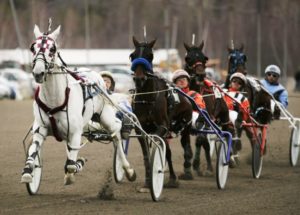
With the development of the starting gate, pari-mutual betting, and night time “lit” racing, postwar economic prosperity turned peoples’ interests towards levity, escapism, and harness racing.
Weekend gamblers filled racing venues with the weekend, track-fan numbers topping 10,000 in attendance. Horse racing enthusiasts were treated to the fastest horses and best drivers in the USA. Horse betting was becoming legalized. There was no state lottery. Atlantic City Casinos did not exist. Entertainment choices were limited. —Harness Racing Vehicles, Susan Green
Meanwhile, booming post-war economic prosperity provided the means to . . . well, prosper.
- In New York, Roosevelt Raceway had opened in 1940
- In New York, Monticello Race Track opened June 27, 1958
In 1959, gambling became legalized in Pennsylvania with the passing of the Race Horse Industry Reform Act.
- In Pennsylvania, the Meadows Racetrack opened in 1963
- In Pennsylvania, Pocono Downs opened in 1965
Post-WWII, the abundance of raw materials coupled with sulky horsemen eager for new race bikes and jog carts, spurred Jerald Sulky’s growth and diversification into horse show vehicles, including modern versions of classics such as the Fine Harness Buggy, the Devon Viceroy, and the Show Pleasure Cart.
Jerald Sulky Company—2015 to 2020
Need a Cart? Buy the Company.
In 2015, Erik Lee, a lifelong consumer of the Jerald Sulky product, needed a driving cart. “I’ve trained driving horses throughout my career. At that time, a three-year-old Hackney pony colt, named Flying First Class (barn name Jedi), that I bought as a yearling was showing great potential,” says Erik Lee.
“So I called Jerald Sulky to buy a Show Pleasure Driving Cart for Jedi,” remembers Lee. “As it turns out, Jerald Sulky had been furloughed barely . . . a month before I called. So it is a true story! I called to buy a cart and instead ended up buying the company!”
Shelli and Erik Lee purchased the 118-year-old horse carriage company—the Jerald Sulky Company. Erik Lee, is a true horseman, a carriage driver, and USEF horse show judge and judges Saddlebred, Hackney, roadster, and equitation divisions at shows across the USA. They also hope to re-enter the harness-racing sulky business that the company built its notorious reputation throughout the 1800s forward through several generations.
Return to Racing?
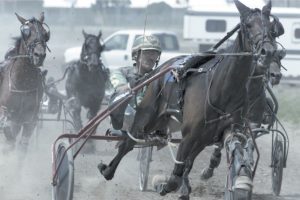
“So I will tell you, and this is very candid,” says Erik Lee. “I bought the company about five years ago. The Jerald Sulky Company was the king of the race business for a really, really, really long time. We would have 80% to 90% of the vehicles on the race track.”
“The family interest [in harness racing] ran out. New ownership [Todd Gordon and Kevin Ireland in 2005] came from show horse interests, and so that’s where they communicated and knew how to talk too.”
“So Jerald, just based on ownership and interests, lost its way in the racehorse world,” shares Lee.
“Today, we have vehicle offerings, but we don’t have something that would be particularly modern and viable. Broder makes the Nitrous bike. Comparatively, [the Nitrous or the UFO], they are almost rudimentary to the stuff we developed. Still, from a functional perspective, they are what’s desired on the track right now,” says Lee.
“The story on the track, currently, we are not a significant contributor to the industry. We make the world’s best jog cart. We sell meaningful quantities of jog carts. Almost don’t sell anything in race bikes, other than to those white-haired, loyal individuals that have a special affinity to the brand,” says Lee appreciatively.

“Right now, we’re not a participant on the track. I want to go back into racing. The size and opportunity of the marketplace is smaller than it used to be. We used to turn out 600-700 vehicles a year that went straight to the track. Those [other bike makers] serving the market place are probably turning out half that in a year combined.”
“Thirty years ago, if you’d gone to see a race, 10 horses, 10 races, you’d see 60-70 bikes on the track, now you might see 15-20 bikes. The number of bikes consumed on the track has gone down significantly. The consumption model has changed,” says Lee.
“We are the last commercial manufacturer of performance horse-drawn vehicles in the world. With a facility that you’ve never seen any equivalent. From a manufacturing perspective, we are still positioned to reset the global racing business. We could do it. It’d just take some investment capital, and Jerald Sulky bikes would be untouchable world-wide. I’m open to the prospect.”
Phone: 319-234-6195
Email: info@jeraldsulky.com
After over 100 years in family hands, now in new ownership, the legacy of The Jerald Sulky Company remains in the care of true horsemen with genuine product passion and drive. Today the company is revitalized with modern engineering principles woven into the history of nearly 120 years of continuous experience. The talented team of craftsmen building Jerald Sulky Company’s line of performance vehicles ranges from apprentices to senior craftsmen with almost 50 years’ experience. The highly-skilled, master-craftsmen staff has 200-plus years of combined experience.
New products are in continual development. Modern updates include a new Super J+ all stainless steel undercarriage jog cart. Refinements are always underway to make the vehicles ever better, such as the recent redesign of the open-wheel hub with modern sealed bearings and milled-shoulder spacers for easy field service.

“If you’re going to step to the plate, you better hit the ball.”—Erik Lee, Jerald Sulky
